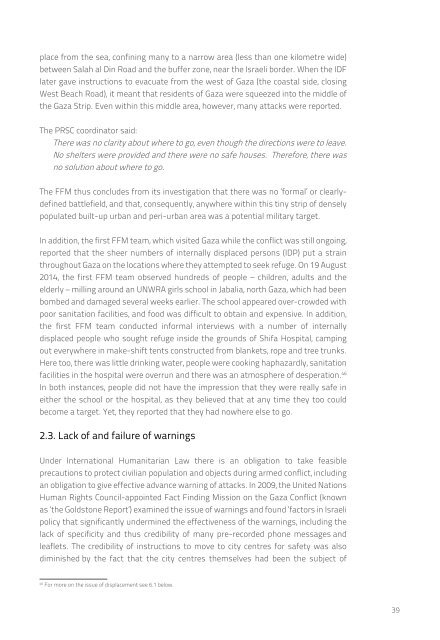HHo0s
HHo0s
HHo0s
You also want an ePaper? Increase the reach of your titles
YUMPU automatically turns print PDFs into web optimized ePapers that Google loves.
place from the sea, confining many to a narrow area (less than one kilometre wide)between Salah al Din Road and the buffer zone, near the Israeli border. When the IDFlater gave instructions to evacuate from the west of Gaza (the coastal side, closingWest Beach Road), it meant that residents of Gaza were squeezed into the middle ofthe Gaza Strip. Even within this middle area, however, many attacks were reported.The PRSC coordinator said:There was no clarity about where to go, even though the directions were to leave.No shelters were provided and there were no safe houses. Therefore, there wasno solution about where to go.The FFM thus concludes from its investigation that there was no ‘formal’ or clearlydefinedbattlefield, and that, consequently, anywhere within this tiny strip of denselypopulated built-up urban and peri-urban area was a potential military target.In addition, the first FFM team, which visited Gaza while the conflict was still ongoing,reported that the sheer numbers of internally displaced persons (IDP) put a strainthroughout Gaza on the locations where they attempted to seek refuge. On 19 August2014, the first FFM team observed hundreds of people – children, adults and theelderly – milling around an UNWRA girls school in Jabalia, north Gaza, which had beenbombed and damaged several weeks earlier. The school appeared over-crowded withpoor sanitation facilities, and food was difficult to obtain and expensive. In addition,the first FFM team conducted informal interviews with a number of internallydisplaced people who sought refuge inside the grounds of Shifa Hospital, campingout everywhere in make-shift tents constructed from blankets, rope and tree trunks.Here too, there was little drinking water, people were cooking haphazardly, sanitationfacilities in the hospital were overrun and there was an atmosphere of desperation. 46In both instances, people did not have the impression that they were really safe ineither the school or the hospital, as they believed that at any time they too couldbecome a target. Yet, they reported that they had nowhere else to go.2.3. Lack of and failure of warningsUnder International Humanitarian Law there is an obligation to take feasibleprecautions to protect civilian population and objects during armed conflict, includingan obligation to give effective advance warning of attacks. In 2009, the United NationsHuman Rights Council-appointed Fact Finding Mission on the Gaza Conflict (knownas ‘the Goldstone Report’) examined the issue of warnings and found ‘factors in Israelipolicy that significantly undermined the effectiveness of the warnings, including thelack of specificity and thus credibility of many pre-recorded phone messages andleaflets. The credibility of instructions to move to city centres for safety was alsodiminished by the fact that the city centres themselves had been the subject of46For more on the issue of displacement see 6.1 below.39


